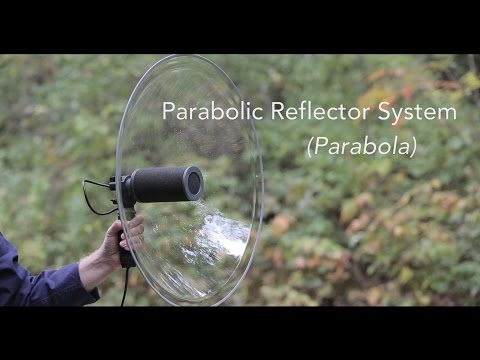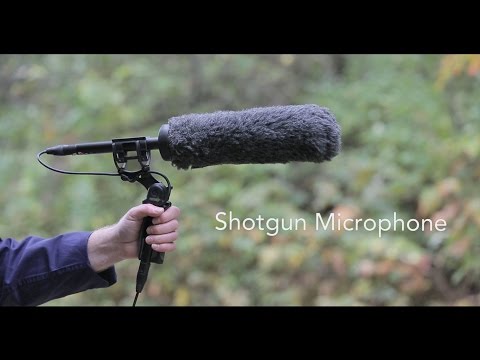Microphones

Parabolic reflector and shotgun microphones are two types of microphone systems frequently used to make wildlife recordings. Both of these are directional, meaning that they help to create a focused recording of a target species while reducing the impact of unwanted background sounds. Because of their properties, parabolic reflectors tend to result in cleaner recordings with less background noise than shotgun microphones under the same circumstances.
A Dusky Flycatcher recorded with a parabolic reflector
A Dusky Flycatcher recorded with a shotgun microphone
Parabolic reflector
 A parabolic reflector system (or “parabola”) consists of a small microphone placed inside of a plastic, aluminum, or fiberglass dish with a parabolic curve. The major benefit of a parabolic reflector system is that it amplifies a target sound, something that a directional microphone does not do. A parabola is extremely effective for making high-quality recordings suitable for audio guides and for recording challenging subjects like high-canopy species or birds with very soft vocalizations.
A parabolic reflector system (or “parabola”) consists of a small microphone placed inside of a plastic, aluminum, or fiberglass dish with a parabolic curve. The major benefit of a parabolic reflector system is that it amplifies a target sound, something that a directional microphone does not do. A parabola is extremely effective for making high-quality recordings suitable for audio guides and for recording challenging subjects like high-canopy species or birds with very soft vocalizations.
Benefits
- Significant amplification of target sound
- Potential for creating high-quality recordings with a high signal-to-noise ratio
- Effectively brings a target bird closer when it is physically impossible for the recordist to get closer
- Extreme directionality helps to minimize background species and other ambient noise
- Ideal for recording a single vocalizing bird
Challenges
- Can be difficult to carry or use in certain habitats due to size, shape, and weight
- Proper aim can be difficult with moving subjects
- Extreme directionality can result in inconsistent signals when a target species moves frequently
- Amplifies higher frequency sounds slightly more than lower frequency sounds
- Does not amplify very low frequency sounds at all
- Does not equally record all members of a group of vocalizing birds
How it works
A parabola’s extreme directionality (in technical terms, a very narrow-angle polar response) is achieved by using a reflector with a geometrically calculated parabolic curve to concentrate incoming parallel (on-axis) sound waves to the reflector’s focal point. Sound pressure waves that pass perpendicularly through the plane of the reflector’s rim are reflected back to the microphone’s capsule, which is positioned at the parabola’s focal point. Sound pressure waves that enter the plane of the dish at an angle (off-axis) are not concentrated at the focal point and therefore are not amplified. For this reason, it is extremely important that a parabola is aimed precisely at the target sound source.
How To Record Audio – ParabolaOther considerations
The diameter of a parabola determines the lowest frequency sound that a parabola can amplify. If the wavelength of a sound wave is greater than the diameter of the parabola, the sound wave will not be captured or amplified by the parabola (but the sound will still be captured by direct contact with the microphone). A parabola does not amplify all frequencies equally. Instead, higher frequency sounds, with shorter wavelengths, are amplified more than lower frequency sounds. When recording with a parabola, wearing a set of headphones and listening for the significant increase in signal strength ensures that the parabola is correctly aimed.
Depending on the parabolic curve of a reflector, the focal point can be located inside the reflector, outside the reflector, or at the rim of the reflector. A parabolic curve that has the focal point at the rim or just inside the rim of the reflector is ideal for bird recording, as this provides some protection against gusts of wind on the microphone (which is located at the focal point). Most parabolas use an omnidirectional microphone in order to pick up reflected sound from the entire surface of the dish. In larger dishes with the focal point at or outside of the rim of the dish, another option is to use a cardioid microphone, which rejects sound to the rear and slightly to the sides of the microphone.
Popular parabola brands
Telinga and Wildtronics are the primary companies that produce parabolic microphone systems (parabolic reflectors with microphones) specifically for wildlife recording. It may also possible to buy a parabolic reflector from other sources, build a microphone mount for the reflector, and add a microphone to create your own parabolic microphone system.
Telinga
The Swedish manufacturer Telinga offers a clear, lightweight, parabolic reflector, available with or without a microphone. The polycarbonate reflector is 57 cm (22 inches) in diameter, and available in two thicknesses: 1 mm or 2 mm. The 1-mm dish is rollable, making it relatively easy to transport on planes, trains, and buses. The 2-mm dish is not rollable, but the harder, thicker dish provides greater durability and reflectivity. Several microphone options are available for Telinga parabolas, including a built-in stereo microphone system, and the Telinga Universal system, which accepts an omnidirectional microphone of your choice. Telinga parabolas are widely used for scientific and commercial applications.
Wildtronics
Wildtronics is an American manufacturer offering a lightweight, rollable parabolic reflector available either in clear or opaque polycarbonate and with or without a microphone. The reflector is available in a 57 cm (22 inch) diameter. The clear version is available in two thicknesses—a rollable 0.76 mm dish and a non-rollable 1.52 mm thickness. Several microphone options are available, including a stereo option, and an All-Purpose Parabolic that allows you to use almost any existing microphone. Their Pro Mono model is one of the most affordable and best value options currently on the market.
Omnidirectional microphones for use in a parabolic reflector
There are many omnidirectional microphone options for use with parabola. At the Macaulay Library, we use the Sennheiser ME62 electret condenser with K6 power module due to its relatively modest cost. The Sennheiser MKH20 RF condenser and Sennheiser MKH8020 modular RF condenser are additional microphones to consider. Other manufacturers of microphones include Røde, AudioTechnica, DPA, and more.
Shotgun microphone
 A shotgun microphone provides a lightweight, compact alternative to a parabolic reflector system. Unlike a parabola, however, a shotgun microphone does not amplify a target sound. Instead, a shotgun microphone’s directionality is based on having “areas of rejection” on its sides to reduce the level of sounds in these areas. Shotgun microphones are excellent for documentation and research recordings, but are limited in their ability to produce the very highest-quality recordings.
A shotgun microphone provides a lightweight, compact alternative to a parabolic reflector system. Unlike a parabola, however, a shotgun microphone does not amplify a target sound. Instead, a shotgun microphone’s directionality is based on having “areas of rejection” on its sides to reduce the level of sounds in these areas. Shotgun microphones are excellent for documentation and research recordings, but are limited in their ability to produce the very highest-quality recordings.
Benefits
- Easy to transport, handle, and aim even in dense habitat
- Does not require the precise aim necessary for a parabola
- Greater range of less expensive options available than for a parabola
- Good for capturing duets, flock sounds, and other sounds with more than one individual
- Does not emphasize higher frequency sounds
- Reasonably good directionality for higher frequency sounds
Challenges
- Does not amplify target sounds
- Less directional than a parabola, making it difficult to create high-quality recordings with a high signal-to-noise ratio
- Off-axis mid and high frequency sounds will be altered due to the shotgun’s phase reactive property
How it works
A shotgun microphone is an interference tube: a long cylinder with a series of openings, or ports, along its length. The design of the interference tube is what gives a directional microphone its directionality. The ports act as phase equalizers, controlling signals from outside the microphone’s angle of acceptance so that these off-axis signals cancel each other out. The longer the interference tube, the more directional the microphone.
How To Record Audio – Shotgun MicrophoneOther considerations
Because a shotgun microphone is less directional than a parabolic microphone, it is easier and faster to aim. In addition, its size and shape make it especially easy to carry in the field. The shotgun microphone is especially useful for recording groups of birds, birds in flight, and other actively moving birds. For these reasons, and its greater range of low cost options, many people conducting biological inventories or leading bird tours prefer to use a shotgun microphone.
Popular shotgun microphone brands
Sennheiser microphones are most commonly used by contributors to Macaulay Library, particularly, the Sennheiser ME series electret condenser shotgun microphones (ME66 short shotgun, ME67 shotgun). The Sennheiser MKH series radio-frequency (RF) condenser shotgun microphones and Røde microphones are also common.



